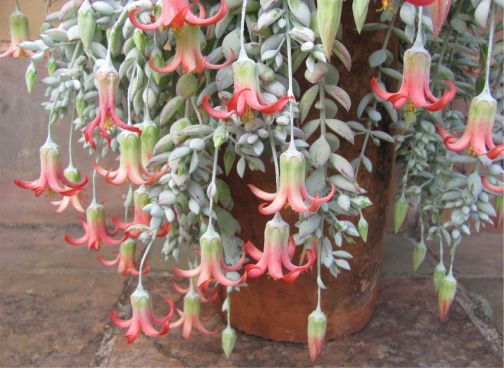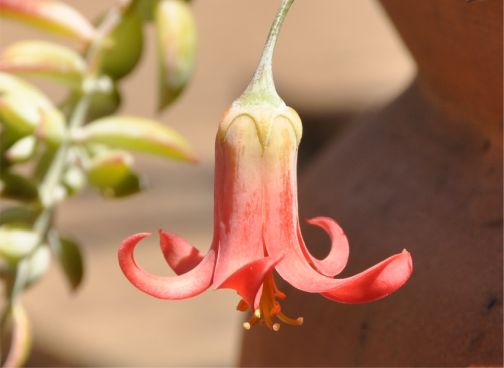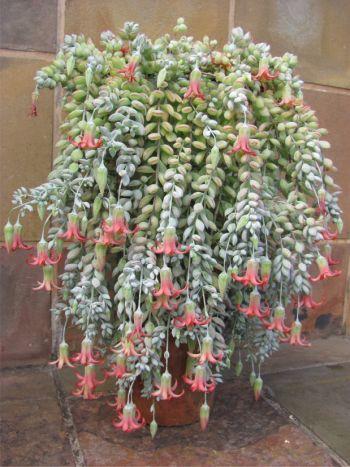Cotyledon pendens
Cotyledon pendens Van Jaarsv.
Family: Crassulaceae
Common names: cliff cotyledon (Eng.); kransplakkie, kransklokkie (Afr.)
Introduction
Cotyledon pendens is a rare succulent shrublet with hanging branches and flowers, only known from sheer cliff faces along the Mbashe River in the Eastern Cape. Ideal for hanging baskets, rockeries and terraces.

Description
Description
Much-branched succulent shrublet with dense, curtain-forming, hanging stems up to 600 mm long. Its roots are fibrous and not succulent. The stems are initially soft and flaccid, ± 2 mm in diameter, whitish green (due to a powdery bloom) and the nodes are about 7-15 mm apart. The stems and leaves are at first sparsely beset with glandular hairs, becoming hairless with age (glabrescent). Its leaves are often crowded and highly succulent, in opposite pairs, pendent, the leaf blades (lamina) are elliptic to elliptic-egg-shaped (ovoid), 18-25 x 10-15 mm and 7-10 mm thick, the tip (apex) ending abruptly in a sharp point (mucronate), the base is wedge-shaped. The leaf surface is whitish grey-green due to the powdery bloom, the leaf margin is an attractive reddish colour. The short petiole is 1.5-2.0 mm long. The inflorescence is produced at the ends of the branches, it is branched and hanging and 50-90 mm long, with up to 4 flowers (sometimes only a single flower). The flower stalk is about 8-18 mm long and 2 mm in diameter. The flowers are bell shaped, orange-red 40-45 x 12-13 mm with a cylindrical tube slightly bulging in the middle. The lobes are spreading. Its 10 stamens are produced in two whorls, they are yellowish green and 18-20 mm long, fused into a tube in the lower third. The anthers (male parts) are spherical bearing yellow pollen. Flowering time is in midsummer.

Conservation Status
Status
Cotyledon pendens is a Rare species, a habitat specialist confined to a small area, that is not threatened.
Distribution and habitat
Distribution description
Cotyledon pendens is only known from sheer cliff faces along the Mbashe River in the Eastern Cape (former Transkei region). The Mbashe River is a large river which has its origin in the Drakensberg of the Eastern Cape. The vegetation in the region is mainly grassland and the lower part of the deep gorge (where this plant can be found) is covered with dense Eastern Valley Bushveld. Cotyledon pendens grows on sheer south-facing shale cliffs in a predominantly summer rainfall region. The summers are hot, winters cooler, dry and without frost. Rainfall occurs mainly during summer and ranges between 1000-1250 mm (mainly thundershowers, October to May). Plants grow firmly-rooted in crevices forming drooping mats (cliff hanger) at an altitude of 300-400 m above sea level.
The plant shares its habitat with other cliff-dwelling plants such as Aloe reynoldsii, Bulbine thomasiae, Adromischus liebenbergii subsp. orientalis, Albuca batteniana, Ornithogalum longibracteatum, Drimia anomala, Drimia loedolffiae, Haworthia cymbiformis var. setulifera, Crassula cordata, C. intermedia, C. perforata, Ceropegia sandersonii (southernmost record), Peperomia blanda, Rhipsalis baccifera, Ledebouria ensifolia, Haemanthus albiflos, Plectranthus hadiensis and Pelargonium acraeum. Other non-succulent plants observed in the habitat include: Ficus burtt-davyi, F. burkei, Schotia latifolia and Bauhinia bowkeri.

Derivation of name and historical aspects
History
Cotyledon pendens was named in 2003 from plants collected by Paul Emms and the author while exploring cliffs of the lower Mbashe River in October 2001, as part of the author's study of cliff-dwelling succulents and succulent bulbous plants. The plants were spotted on sheer cliffs, and a few cuttings were obtained by throwing rocks at the plants. The plant was named by the author in the magazine Aloe in 2003. The specific epithet pendens pertains to its pendent growth habit.
Cotyledon pendens is one of 11 species of Cotyledon occurring in South Africa. It belongs to the Stonecrop family (Crassulaceae) which is very well represented in South Africa, especially in dry habitats. Cotyledon pendens is immediately distinguished by its pendent branches bearing small grey-green oval-elliptic leaves and pendent bell-shaped flowers. It is closely related to Cotyledon woodii, but differs by its flaccid pendent growth and branched inflorescence. As with C. woodii, it often produces solitary flowers. Cotyledon woodii is a sturdy woody erect shrub up to 1 m high known from the southern parts of the Eastern Cape which grows in varied habitats and also occasionally on cliffs, however sustaining its erect woody growth.
Ecology
Ecology
Plants have a pendent growth which is retained in cultivation, and are thus well adapted to the sheer habitat. The drooping stems will root where they come in contact with any crevice, establishing new clones. The grey-green succulent leaves, covered with powdery bloom, are an adaptation to its dry habitat. Cotyledon pendens has conspicuous orange-red bell-shaped flowers pollinated by sunbirds.

Uses
Use
No medicinal or cultural uses have been recorded. It is a popular and rewarding ornamental plant ideal for hanging baskets.
Growing Cotyledon pendens
Grow
Plants grow well in cultivation and are best suited for dry gardens where frost is absent or very light. It would be ideal for window sills and balconys. Plants are mat-forming and due to their habit should help prevent erosion. They can be grown on steep embankments where branches should soon becoming pendent. They also thrive in hanging baskets and containers.
Best grown from cuttings during the warmer months. They can be planted in sand and kept moist, in a sunny or partially shaded area. Rooting is rapid and plants can be planted out directly to the chosen site or container. Plants also grow from leaf cuttings rooted in sand, which is unique among the Cotyledon species
References
- Van Jaarsveld, E.J. & Van Wyk, A.E.. 2003. New cliff-dwelling Crassulaceae from the Eastern Cape: a new Cotyledon and two new Adromischus taxa from the Mbashe and Mzimvubu Rivers, South Africa. Aloe 40,2: 36-40.
- Van Jaarsveld, E.J. & Koutnik, D. 2004. Cotyledon and Tylecodon.Umdaus Press.
Credits
Ernst van Jaarsveld
Kirstenbosch National Botanical Garden
August 2009
Plant Attributes:
Plant Type: Succulent
SA Distribution: Eastern Cape
Soil type: Sandy, Loam
Flowering season: Early Summer
PH: Acid, Neutral
Flower colour: Orange
Aspect: Full Sun, Shade
Gardening skill: Easy
Special Features:
Horticultural zones








Rate this article
Article well written and informative
Rate this plant
Is this an interesting plant?
Login to add your Comment
Back to topNot registered yet? Click here to register.